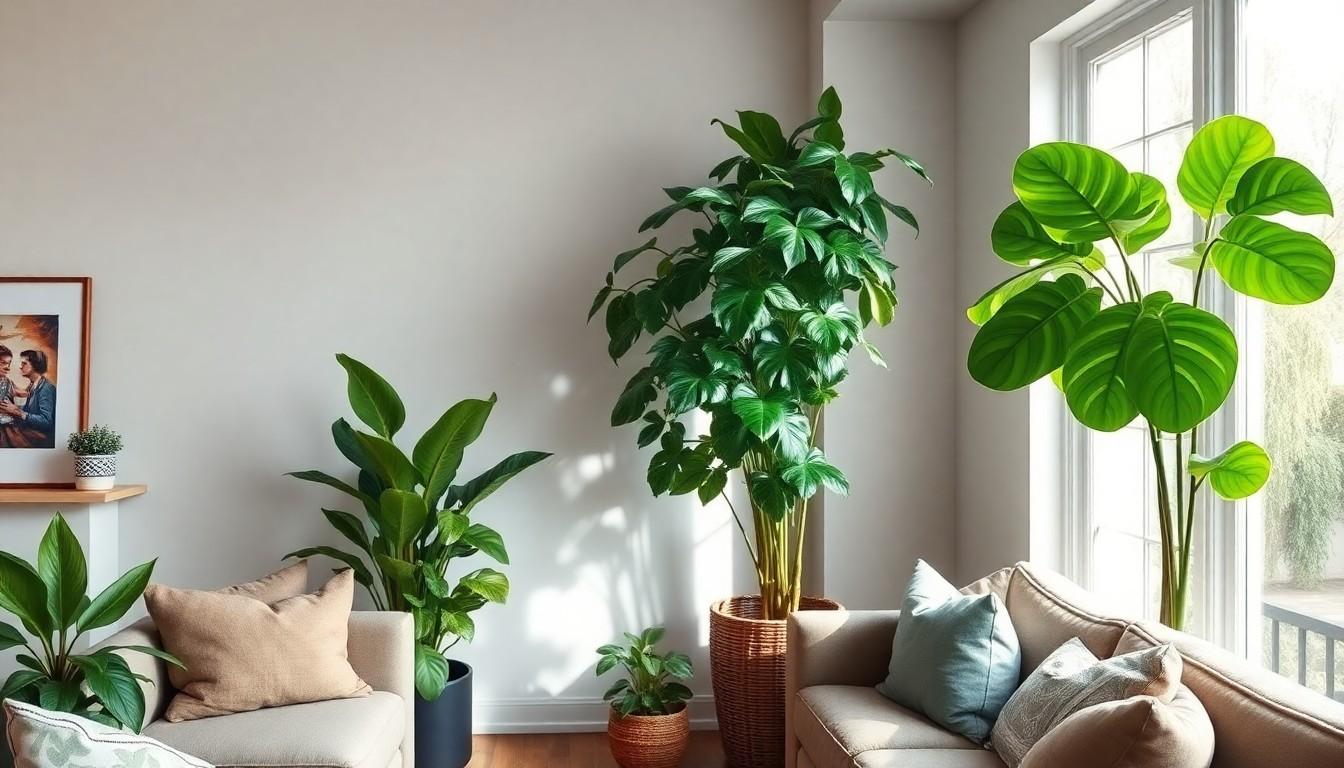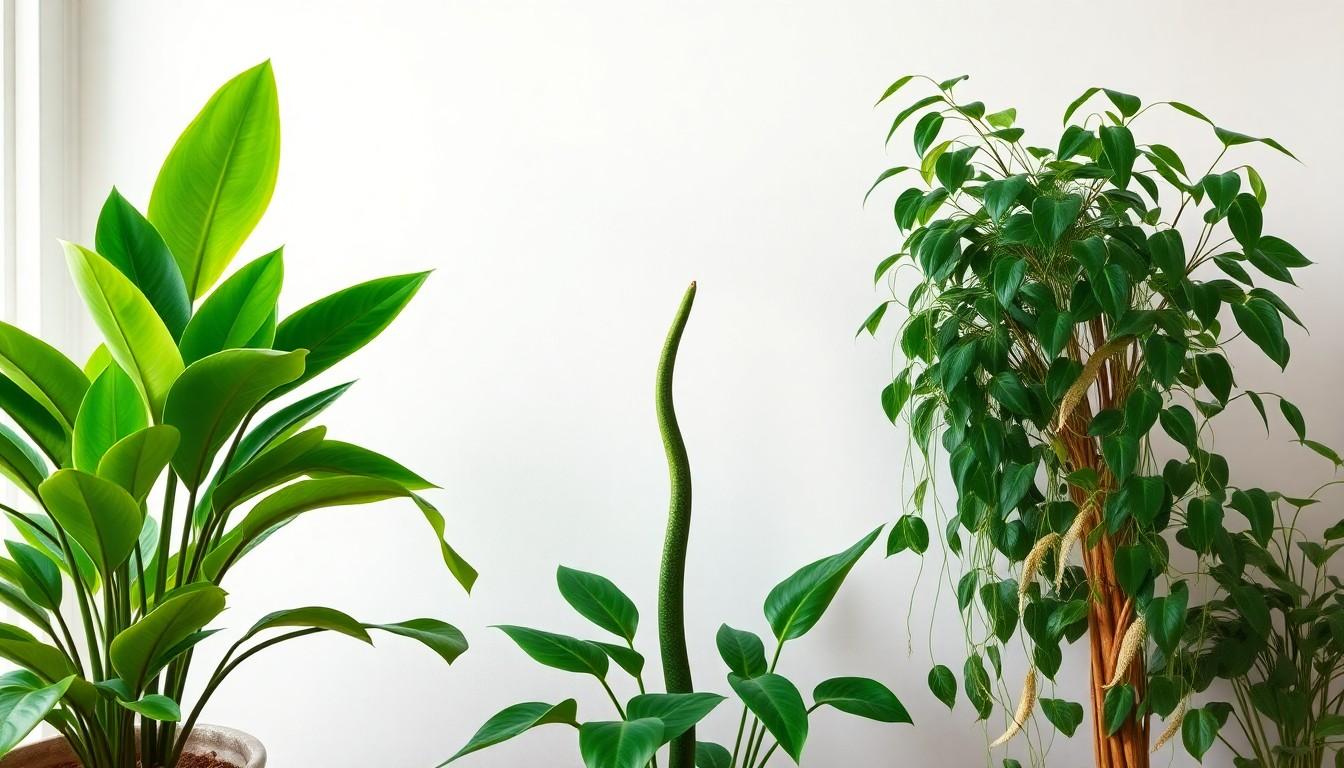Physical Address
304 North Cardinal St.
Dorchester Center, MA 02124

Imagine transforming your living space into a lush oasis without needing a sunroom or a green thumb. Tall house plants thrive in low light, adding a touch of nature that even the sunniest of personalities would envy. These leafy giants not only elevate your décor but also purify the air, making your home feel fresh and inviting.
Tall house plants bring a unique aesthetic element to indoor spaces. Different varieties offer various heights and shapes, allowing homeowners to find the perfect fit for their décor. Low light conditions don’t deter these plants, making them ideal for almost any room.
Some popular tall house plants include the Snake Plant, which can grow over three feet tall. The ZZ Plant also thrives in low light, reaching similar elevations while requiring minimal care. Both options exhibit resilience, thriving in indirect sunlight.
Fiddle Leaf Figs present another option; they can grow up to six feet and add a bold statement to any corner. They prefer bright, indirect light but adapt surprisingly well to lower light levels. Their large leaves filter air, providing additional health benefits.
Pothos, another tall option, offers trailing vines that can grow long and lush. While typically known for being a hanging plant, they can also be trained to stand tall in decorative pots. These plants tolerate low light, which makes them accessible to various indoor environments.
Incorporating these types of plants into a living area can significantly elevate the ambiance. The visual height draws the eye upward, creating a sense of spaciousness. Busy schedules do not hinder plant care; many of these varieties require only sporadic watering and occasional dusting of leaves.
Considering the right placement in a room enhances their overall impact. Creating a focal point with a tall plant can lead to a modern feel and invigorate the atmosphere. Making informed choices about plant species ultimately leads to a healthier indoor environment.

Tall house plants thrive in low light, bringing life to various spaces. The following selections showcase resilience and adaptability.
ZZ Plant stands out for its glossy leaves and robust nature. It grows up to three feet tall and requires minimal maintenance. This plant tolerates neglect and low light, making it perfect for busy lifestyles. Watering is infrequent, as its rhizomes store moisture, ensuring it survives periods of drought. Additionally, the ZZ Plant purifies air, contributing to a healthier living environment.
Snake Plant is known for its striking vertical leaves and ability to thrive under low light. Reaching heights of up to four feet, it adds a modern touch to any room. Adaptability is one of its key features; it can survive in indirect sunlight and withstand drought. This plant requires watering only when the soil dries out, making it remarkably low-maintenance. Moreover, Snake Plant improves indoor air quality by filtering toxins, promoting a fresh atmosphere.
Pothos brings versatility with its trailing vines and ability to climb or cascade. This plant can grow tall when given support, reaching heights of three to four feet. It flourishes in low light and thrives in various conditions, making it ideal for different indoor settings. Frequent watering isn’t necessary; watering occurs when the top inch of soil dries out. Pothos also provides air-purifying benefits, maintaining a cleaner space and enhancing the overall aesthetic.
Caring for tall house plants in low light conditions requires specific techniques to ensure healthy growth. These plants thrive in indirect sunlight, making it essential to understand their needs.
Watering tall house plants, like the ZZ Plant and Snake Plant, requires attention to soil moisture. Allow the top inch of soil to dry out before watering again. Overwatering can lead to root rot, while underwatering might cause wilting. Use a pot with drainage holes to prevent excess moisture. On average, these plants thrive with watering every two to four weeks, depending on humidity levels in the home.
Fertilization should occur during the growing season, which typically spans spring to early fall. Use a balanced, water-soluble fertilizer diluted to half strength. Apply this mixture every 4-6 weeks to support healthy growth without overwhelming the plant. During the dormant winter months, reduce fertilization frequency, as these plants require less nutrients during this time.
Pruning helps maintain the shape and health of tall house plants. Trim dead or yellowing leaves to encourage new growth and improve aesthetics. Make cuts at the base of the stem to promote a fuller appearance. Regularly checking for pests and diseases will prevent damage to the plant. Performing light pruning throughout the growing season keeps plants looking their best while removing unwanted growth.
Enhancing the aesthetic appeal of a space, tall house plants serve as striking focal points. Strong visual presence provides an elegant ambiance, making any room feel more inviting. They also improve indoor air quality, filtering pollutants and increasing oxygen levels, which contributes to a healthier environment.
Space utilization becomes more efficient with these plants, as they draw the eyes upward, creating an illusion of greater height and openness. Lower light conditions tend to limit plant options, yet these tall varieties thrive with minimal sunlight exposure.
Minimal maintenance requirements align with busy lifestyles, allowing individuals to enjoy greenery without extensive care routines. ZZ Plants, for example, adapt remarkably well to low light, maintaining a lush appearance without frequent watering. Snake Plants offer a similar ease, often growing vigorously in indirect light.
Moreover, these plants contribute to psychological well-being. Greenery in indoor spaces promotes tranquility, reduces stress, and enhances mood. The presence of tall house plants instills a sense of connection to nature, fostering a calming environment.
Caring for tall house plants encourages mindfulness as individuals engage in their upkeep. Simple routines, such as checking soil moisture levels and pruning, can provide satisfaction and strengthen the bond with their greenery.
Ultimately, tall house plants in low light spaces not only elevate décor but also contribute positively to health and well-being. These plants transform environments, making them vibrant and life-enhancing.
Tall house plants thrive in low light and offer a range of benefits that enhance any living space. They not only serve as stunning décor but also improve air quality and create a calming atmosphere. With options like the ZZ Plant and Fiddle Leaf Fig, even those with busy lifestyles can enjoy the beauty of greenery indoors.
Incorporating these plants into a home can transform environments, making them feel more spacious and inviting. The psychological uplift from caring for these plants adds to their appeal, promoting relaxation and well-being. By choosing the right tall plants and following simple care tips, anyone can create a vibrant and life-enhancing indoor oasis.